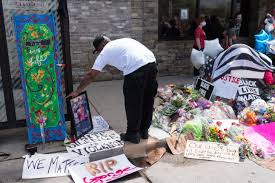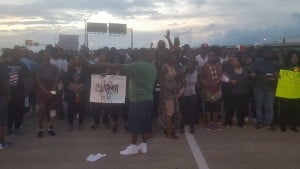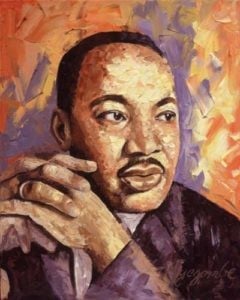 The Journal of Contemporary Rhetoric invited R3 editor Andre E. Johnson to guest edit a special issue of the journal titled “Understanding the Rhetoric(s) of Race. Below is the introductory essay to the special issue.
The Journal of Contemporary Rhetoric invited R3 editor Andre E. Johnson to guest edit a special issue of the journal titled “Understanding the Rhetoric(s) of Race. Below is the introductory essay to the special issue.
When we first invited scholars and sent out a call for papers on a special issue on Understanding the Rhetoric(s) of Race, there had been much in the media in regards to race and racism. We noted that from the discussions that many had regarding the acquittal of George Zimmerman, to the killing of Michael Brown, Tamir Rice, Eric Garner and others; from the continued protests in Ferguson; to how politicians talk about and use race in deliberation and policy making, race, how it functions, and more importantly, how we communicate it had been at the forefront. At the time many also called for reconciliation and the proverbial “conversations on race.” However, despite our higher aims, race, race-based appeals, and overall racist rhetoric still was plentiful.
Therefore, with this in mind, we invited submissions for a special issue focusing on the intersection of rhetoric and race. The goal was to offer new insights that would begin to frame future communication studies on race, racism, and racialized discourses. In keeping with the mission of the Journal of Contemporary Rhetoric, we sought papers that promoted “public intellectualism by providing scholarly analysis of current events.” We believe that essays in this journal “should add to the public discussion of current events and help the public understand more fully the theoretical underpinnings of public debates and controversies, political discourse, social movements, and media events.”
Therefore, we were interested in essays that would contribute to our current knowledge of the rhetorics of race, while revealing their historical and cultural significance through detailed case studies of discourse across a wide range of contemporary contexts. In addition, our hope was to demonstrate ways racial knowledge and power becomes possible through rhetorical inquiry. With the following essays, we feel that we achieved our goals
The first two essays focus on the phrase “Black Lives Matter.” Critical Race scholars David Leonard and Julius Bailey suggest that we should see Black Lives Matter as an active movement focused not on the future, “but with our present moment.” They argue that an understanding of Black Lives Matter would see that it is a movement “principally in the here and now” and it is that present availability that continues to move the movement forward. They maintain that by engaging in social media “with its endless framing and shaping of the immediate present,” not only can proponents and supporters of Black Lives Matter continue to grow, but they also can fend off opponents and detractors and expose racist assumptions that have led to the marginalization of people of color. Proponents achieve this by radicalizing Black love, reclaiming Black death, challenging White Privilege and having the audacity of the dream.
In the second essay, communication scholars Catherine L. Langford and Montené Speight argue that the #BlackLivesMatter hashtag offers “an ideology counter to the historical and contemporary framing of African Americans that strips them of social value.” As a hashtag, #BlackLivesMatter “attempts to alter the epistemic paradigm that exists in American discursive and material actions.” Proponents of #BlackLivesMatter do this by “drawing attention to the habitual violence against Blacks in America” while at the same time offering positive and redeeming messages about the “individual and communal worth of Black lives.” Further they maintain that the hashtag teaches auditors that “Black persons have a positive presence, that violence against the Black body is news, that white privilege exists, and that colorblind rhetoric does not help bring about equality or justice.”
Communication scholar and race theorist Mark Orbe in the next essay draws from Critical Race Theory to explicate how “post-racial fantasies render the legitimacy of race-specific assertions as null and void.” Specifically he argues that the hashtag “#AllLivesMatter is akin with larger rhetorical devices—like the notion of a color-blind society—that are used to promote postracism.” After offering a brief description of Black Lives Matter, Orbe offers a rhetorical critique of #AllLivesMatter and closes the essay by arguing for the necessity of Black Lives Matter.
With the “hoodie” at the forefront of her analysis, in the next essay, Kristen Ann Hungerford examines how it and other forms of protest rhetoric advocated “Justice for Trayvon” Through the use of these protest symbols, Hungerford first, “observes different readings of the rhetorical functions and possibilities of wearing the hoodie, as is evident by black and white protesters” and second, examines how “protesters identified with Martin and how race, as an identity category, functions in these different forms of rhetoric.” Hungerford argues that while others can support the cause of racial justice by wearing hoodies and other artifacts, this type of protest rhetoric is “most effective when persons who have lived experiences of marginalization, in this case particularly black men, demonstrate and don symbols of racial injustice.”
The next two essays focus on Barack Obama and race. In the first one, Scott Anderson argues that while most scholars credit Obama with an “inclusive rhetorical strategy” when talking about race of raced themed topics, Obama prefers to “contextualize race paradoxically, thus creating a type of disunity.” Drawing from Michael Mendelson’s use of controversia; the process whereby speakers present both pro and contra reasoning within one complex argument to establish the grounds for deliberation, Anderson further argues that “while this strategy contributed to Obama’s success in ‘A More Perfect Union’ and in the ‘Trayvon Martin’ speech, news media largely deemed his response to ‘Michael Brown’ a failure.” Anderson maintains that the success and failure of each speech hinged primarily on the “constraints surrounding each speaking occasion and its intended audience.”
In the next essay, I examine Obama’s “impromptu” speech given in the Press Briefing Room in response to the George Zimmerman verdict. I argue that Obama frames the killing of Trayvon Martin and the subsequent acquittal of George Zimmerman as a national tragedy and worthy of commemoration. In short, Obama articulates to the American people the pain that African Americans felt after the verdict and invites all Americans to mourn. Moreover, I argue that by framing black pain at the center of this “American tragedy,” Obama invited all Americans to see “blackness” and its pain as part of the American fabric.
The next two essays examine the intersections of race and health. In the first, religious studies scholar Kendra Hotz “explores the relationship between the discourses of religious belonging and health care among African-American women in Memphis, Tennessee.” Hotz argues that “the language and practices of biomedical contexts can work at cross purposes with the goal of encouraging good self-care, but that the insights of narrative medicine and womanist theology represent helpful correctives.” Further Hotz argues that an analysis of the language of self care offers a “new way of construing the relationship between health seeker and health care provider that has the potential to disrupt the unconscious bias among health care providers that leads to disparities in treatment for racial and ethnic minorities.”
In the second essay that examines the intersection of race and health, communication scholars Amber Johnson and Kesha Morant Williams examine the LifeAlways billboard campaigns and website. They argue that the LifeAlways billboard campaign, while attempting to “lessen the number of abortions performed on Black women,” in turn add to “existing health disparities and impedes any potential progress towards reproductive justice by spreading negative health messages.” They further maintain that LifeAlways health messages aimed at Black women consistently “deny agency, voice, and health.” In closing, Johnson and Morant Williams offer what they call “pro-health”—a “culturally relevant alternative that engages Black women’s voices, agency, narratives, and health disparities fully.”
Our closing essay, by rhetoric scholar Kimberly P. Johnson argues that a womanist perspective could be helpful when discussing race and racism. Ultimately, she argues, “a womanist rhetorician not only serves to liberate women, but all oppressed people of all races, ethnicities, sexualities, and genders.” Further, she adds, “womanist criticism must analyze the ideology of domination that marginalizes individuals until it is able to construct a rhetorical agency that affirms the humanity of those who are marginalized.”
I would like to thank first, Brett Lunceford, editor of the Journal of Contemporary Rhetoric for inviting me to guest edit this issue. I also thank him for having the visionary insight for creating such a journal. Second, I would like to thank the reviewers who took the time to review the essays. You offered good constructive criticism, and while several essays did not make it into this issue, we hope to see some of those published soon in future issues of the journal.
Read the issue here
Donate to the Work of R3
Like the work we do at Rhetoric Race and Religion? Please consider helping us continue to do this work. All donations are tax-deductible through Gifts of Life Ministries/G’Life Outreach, a 501(c)(3) tax exempt organization, and our fiscal sponsor. Any donation helps. Just click here to support our work.












